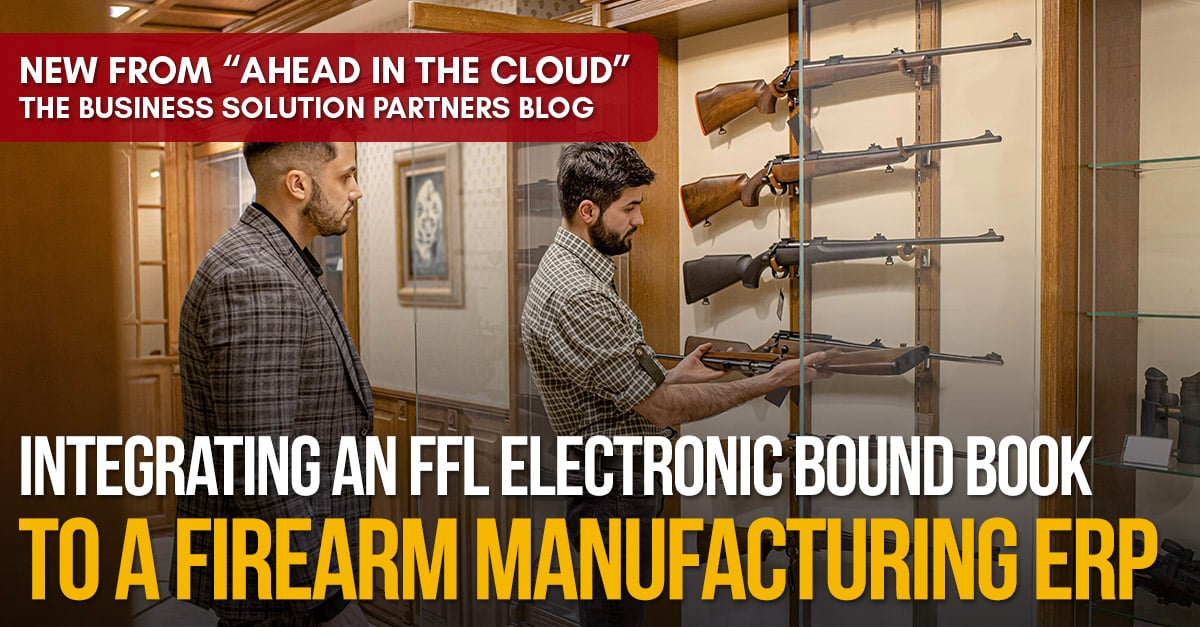3 Functions Your E-Commerce Inventory Management Systems Should Support
Technology solutions can help distributors to tailor their e-commerce inventory management systems to fit the demands of the 21st century.
2 min read
Anthony Meshnick
:
Mar 23, 2021 9:00:00 AM

Gun sales spiked in 2020, so many Type 07 and Type 10 FFLs have looked to ERP and eBound solutions as they ramp up production. Gun manufacturers of all sizes benefit from integrating operational inventory objectives with ATF compliance to increase accuracy and efficiency. These integrations can come in many forms, including ERP-to-eCommerce and ERP-to-Laser, but the need for ERP-to-Bound Book integration is often most pressing.
Industry executives should take into account the following considerations when integrating an FFL Electronic Bound Book with a Firearm Manufacturing ERP.
In response to the increasing demand for ATF eBound Book solutions, a new wave of software providers that cites experience with ERP solutions has arisen. However, firearm manufacturing and ERP technology are very different from gun store operations and retail point-of-sale systems. Demand Planning, Bills of Material, Routings, Production Control, MRP and MRP-II, and more are specific to manufacturing. Applying a retail solution to a manufacturing ERP can be dangerous and perilous.
Some “API-experienced” retail providers charge high rates for designing a solution for the environment of firearm manufacturers, but this essentially makes the client a test subject for a solution that’s unproven in the ATF space.
Because of this, the process of choosing a manufacturing eBound Book solution should include a comprehensive review of the credentials of the software provider within the manufacturing arena, specifically with firearm ERP implementations.
If the eBound software provider has extensive experience with NetSuite, Microsoft 365, Oracle, Sage, SAP, or Epicor, the integration should be relatively simple and straightforward. The effort should also be efficient and operable within a month of purchase.
After integration, all the data that flows into the ATF eBound Book will originate from the manufacturing ERP. Therefore, it’s essential to understand that the “source of truth” in your recordkeeping begins in the Item Master, Vendor Master, and Customer Master files in the ERP. This data, combined with inventory transaction dates, makes up the acquisitions and dispositions information the ATF will inspect.
The source of truth lies within your operational software environment, so the company must recognize how purchasing, engineering, and sales functions can impact compliance.
For instance, the manufacturing, shipment, and disposition of a new rifle include regulated fields for the manufacturer, the model, the caliber/gauge, and the type, but these parallel non-regulated customer-facing fields. Modifying this data from what is engraved on the firearm can cause incorrect eBound Book entries, so whoever designs and implements an integrated ERP/eBound Book solution must assess how to design the item master.
Options may include:
Operational inventory transactions and ATF-regulated transactions (e.g. acquisitions and dispositions) are not identical. Overlap exists, but not everything that happens must be recorded in the eBound Book.
Let's consider a firearm received under a return merchandise authorization (RMA) for credit. The customer service team unpacks the delivery and records the firearm in the ERP. Later, an employee discovers that it wasn’t a return for credit, but rather it was sent in for repair. This would require some form of a financial adjustment in many ERP systems, which could be triggered by backing out the transaction and reentering it correctly. But what happens to the acquisition and disposition records of fully integrated manufacturers? Do non-ATF transactions wind up in the eBound Book even though they shouldn’t?
Mapping the operational activities in your factory to the eBound Book API is the solution. Otherwise, use a firearm ERP accelerator program designed to reduce both cost and risk by leveraging years of ERP experience.
Business Solution Partners is a leading expert in custom API integrations. We've partnered up with Orchid Advisors LLC to identify and deploy business management software solutions that accommodate firearms manufacturers without jeopardizing ATF compliance. Contact us to discuss the best options for your business, or click here for more info.
Technology solutions can help distributors to tailor their e-commerce inventory management systems to fit the demands of the 21st century.
Real-time inventory management can boost customer satisfaction by allowing buyers to get what they want, when they want it.
Distributors need to be vigilant in identifying inventory management inefficiencies in the warehouse to avoid unnecessary costs and to increase...